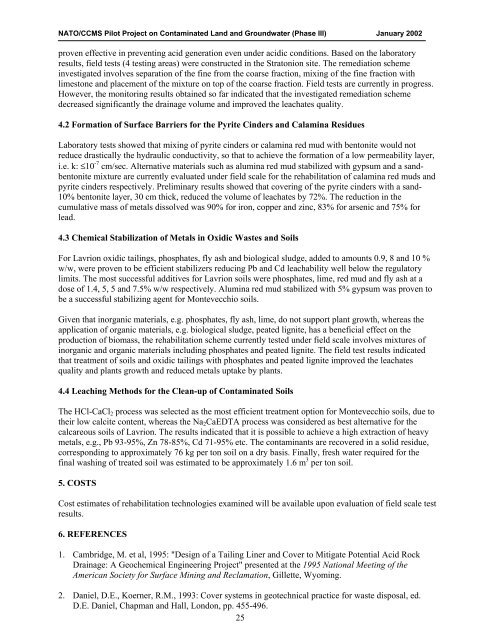NATO/CCMS Pilot Study Evaluation of Demonstrated and ... - CLU-IN
NATO/CCMS Pilot Study Evaluation of Demonstrated and ... - CLU-IN
NATO/CCMS Pilot Study Evaluation of Demonstrated and ... - CLU-IN
You also want an ePaper? Increase the reach of your titles
YUMPU automatically turns print PDFs into web optimized ePapers that Google loves.
<strong>NATO</strong>/<strong>CCMS</strong> <strong>Pilot</strong> Project on Contaminated L<strong>and</strong> <strong>and</strong> Groundwater (Phase III) January 2002<br />
proven effective in preventing acid generation even under acidic conditions. Based on the laboratory<br />
results, field tests (4 testing areas) were constructed in the Stratonion site. The remediation scheme<br />
investigated involves separation <strong>of</strong> the fine from the coarse fraction, mixing <strong>of</strong> the fine fraction with<br />
limestone <strong>and</strong> placement <strong>of</strong> the mixture on top <strong>of</strong> the coarse fraction. Field tests are currently in progress.<br />
However, the monitoring results obtained so far indicated that the investigated remediation scheme<br />
decreased significantly the drainage volume <strong>and</strong> improved the leachates quality.<br />
4.2 Formation <strong>of</strong> Surface Barriers for the Pyrite Cinders <strong>and</strong> Calamina Residues<br />
Laboratory tests showed that mixing <strong>of</strong> pyrite cinders or calamina red mud with bentonite would not<br />
reduce drastically the hydraulic conductivity, so that to achieve the formation <strong>of</strong> a low permeability layer,<br />
i.e. k: ≤10 -7 cm/sec. Alternative materials such as alumina red mud stabilized with gypsum <strong>and</strong> a s<strong>and</strong>bentonite<br />
mixture are currently evaluated under field scale for the rehabilitation <strong>of</strong> calamina red muds <strong>and</strong><br />
pyrite cinders respectively. Preliminary results showed that covering <strong>of</strong> the pyrite cinders with a s<strong>and</strong>-<br />
10% bentonite layer, 30 cm thick, reduced the volume <strong>of</strong> leachates by 72%. The reduction in the<br />
cumulative mass <strong>of</strong> metals dissolved was 90% for iron, copper <strong>and</strong> zinc, 83% for arsenic <strong>and</strong> 75% for<br />
lead.<br />
4.3 Chemical Stabilization <strong>of</strong> Metals in Oxidic Wastes <strong>and</strong> Soils<br />
For Lavrion oxidic tailings, phosphates, fly ash <strong>and</strong> biological sludge, added to amounts 0.9, 8 <strong>and</strong> 10 %<br />
w/w, were proven to be efficient stabilizers reducing Pb <strong>and</strong> Cd leachability well below the regulatory<br />
limits. The most successful additives for Lavrion soils were phosphates, lime, red mud <strong>and</strong> fly ash at a<br />
dose <strong>of</strong> 1.4, 5, 5 <strong>and</strong> 7.5% w/w respectively. Alumina red mud stabilized with 5% gypsum was proven to<br />
be a successful stabilizing agent for Montevecchio soils.<br />
Given that inorganic materials, e.g. phosphates, fly ash, lime, do not support plant growth, whereas the<br />
application <strong>of</strong> organic materials, e.g. biological sludge, peated lignite, has a beneficial effect on the<br />
production <strong>of</strong> biomass, the rehabilitation scheme currently tested under field scale involves mixtures <strong>of</strong><br />
inorganic <strong>and</strong> organic materials including phosphates <strong>and</strong> peated lignite. The field test results indicated<br />
that treatment <strong>of</strong> soils <strong>and</strong> oxidic tailings with phosphates <strong>and</strong> peated lignite improved the leachates<br />
quality <strong>and</strong> plants growth <strong>and</strong> reduced metals uptake by plants.<br />
4.4 Leaching Methods for the Clean-up <strong>of</strong> Contaminated Soils<br />
The HCl-CaCl2 process was selected as the most efficient treatment option for Montevecchio soils, due to<br />
their low calcite content, whereas the Na2CaEDTA process was considered as best alternative for the<br />
calcareous soils <strong>of</strong> Lavrion. The results indicated that it is possible to achieve a high extraction <strong>of</strong> heavy<br />
metals, e.g., Pb 93-95%, Zn 78-85%, Cd 71-95% etc. The contaminants are recovered in a solid residue,<br />
corresponding to approximately 76 kg per ton soil on a dry basis. Finally, fresh water required for the<br />
final washing <strong>of</strong> treated soil was estimated to be approximately 1.6 m 3 per ton soil.<br />
5. COSTS<br />
Cost estimates <strong>of</strong> rehabilitation technologies examined will be available upon evaluation <strong>of</strong> field scale test<br />
results.<br />
6. REFERENCES<br />
1. Cambridge, M. et al, 1995: "Design <strong>of</strong> a Tailing Liner <strong>and</strong> Cover to Mitigate Potential Acid Rock<br />
Drainage: A Geochemical Engineering Project" presented at the 1995 National Meeting <strong>of</strong> the<br />
American Society for Surface Mining <strong>and</strong> Reclamation, Gillette, Wyoming.<br />
2. Daniel, D.E., Koerner, R.M., 1993: Cover systems in geotechnical practice for waste disposal, ed.<br />
D.E. Daniel, Chapman <strong>and</strong> Hall, London, pp. 455-496.<br />
25
















